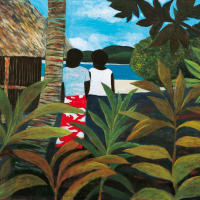51. RAY CROOKE

The single most important element of those which come together to create a Ray Crooke painting is light: it is light which gives the work its ageless quality, mystery and indefinable presence. It is Crookes use of light which provides a sense of tranquil stillness that imbues his most memorable landscape compositions. His ability to express the sensation of light with the arbitrary use of paint elevated Crooke above his many contemporaries who were unable to conjure the same emotional reaction through their work. Rosemary Dobson describes Crookes preoccupation with light and the processes he underwent to achieve the desired effect in paint, he is mesmerised by the sensation of lightthe rest of the painting becomes a foil for this sensation. To obtain it, he may make many adjustments and may find it necessary to put the work away and return to it later with a fresh eye. Or, he may experience that moment of supreme pleasure when, to use his own word, the painting begins to sing.1
The present work, Island Afternoon, demonstrates the emotional response of Crooke to the landscape he painted; the vibrancy and colour of this scene portrays his vision - unimportant details are overlooked so that the emphasis is transferred to the beauty and simplicity of the landscape and its people. Here, Crookes focus is on the closeness of the two figures which is highlighted by his simplification of their surroundings. The foliage and hut are depicted with minimal detail which in turn, causes the red of the figures sarong to appear more vibrant. Crooke employs broad, flat brushstrokes rather than small, painterly dabs to depict the turquoise ocean and sand, again drawing the eye back to the focal point of the work.
The Brisbane gallerist, George Johnstone, who established and developed the careers of many of Australias greatest artists, held eight exhibitions of Crookes work between 1960-72 and knew his work better than most. In the foreword of a catalogue from the 1970 exhibition of the artists work, Johnstone distills the essence of Crookes oeuvre: The pigments of his palette have the shimmering delicacy of memory and nostalgia. He is concerned with a glimpsed, muted, immobile, strangely haunted landscape, where the flow of time past and time present and time eternal is an almost visible, portrayable thing.2
Crookes affection for the landscapes and life of northern Australia and the islands of the Pacific is palpable in his work. For more than four decades, his paintings of island life have endured the cycle of trends and collectibilty - they remain highly sought-after on the secondary market and his work is included in the collections of both state and national art institutions.
Crookes search for the profound subtleties of light, his quiet but intensely evocative landscapes, his native figures glimpsed in the cool of shaded rooms or snared in the webs of light and shade beneath jungle vegetation have made him a very potent and popular Australian painter.3
Footnotes
1. Dobson, R., Focus on Ray Crooke, University of Queensland Press, Brisbane, 1975, p.41
2. George Johnstone, foreword, The Palmer River Paintings by Ray Crooke, The Johnstone Gallery, Brisbane, June, 1970
3. ibid
Caroline Jones BA, MArtAdmin